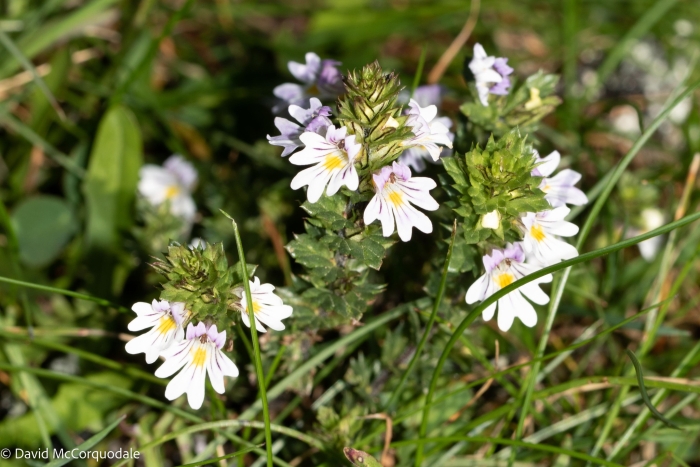Eyebright
(Euphrasia officinalis)
Eyebright (Euphrasia officinalis)
/
/

© David McCorquodale
CC BY 4.0
Image By:
© David McCorquodale
Recorded By:
Copyright:
CC BY 4.0
Copyright Notice:
Photo by: © David McCorquodale | License Type: CC BY 4.0 | License URL: http://creativecommons.org/licenses/by/4.0/ | Uploader: dbmcc09 | Publisher: iNaturalist |





















Estimated Native Range
Summary
Euphrasia officinalis, commonly known as Eyebright, is an annual herbaceous plant native to Europe, including the British Isles, the Balkans, and Northern Europe. It is often found in a variety of habitats, such as meadows, grasslands, and alpine environments, where it prefers well-drained, nutrient-poor soils. Eyebright typically grows to a height of 2-8 inches (5-20 cm) and is characterized by its small, scallop-edged leaves and tiny white or purple flowers with yellow spots and stripes, which bloom from July to September. The flowers are considered modestly showy due to their intricate patterns and are highly attractive to bees and other pollinators.
Eyebright is appreciated for its historical medicinal use, particularly in traditional European remedies for eye-related conditions. In cultivation, it is not commonly found in gardens but may be grown for its quaint appearance and its association with herbal medicine. It requires minimal maintenance, thriving in full sun to partial shade and tolerating a range of soil types, provided they are well-drained. While not widely used in horticulture, it can be an interesting addition to wildflower meadows or naturalistic plantings. However, it is semi-parasitic, drawing nutrients from the roots of nearby plants, which can be a consideration in garden design.CC BY-SA 4.0
Eyebright is appreciated for its historical medicinal use, particularly in traditional European remedies for eye-related conditions. In cultivation, it is not commonly found in gardens but may be grown for its quaint appearance and its association with herbal medicine. It requires minimal maintenance, thriving in full sun to partial shade and tolerating a range of soil types, provided they are well-drained. While not widely used in horticulture, it can be an interesting addition to wildflower meadows or naturalistic plantings. However, it is semi-parasitic, drawing nutrients from the roots of nearby plants, which can be a consideration in garden design.CC BY-SA 4.0
Plant Description
- Plant Type: Herb
- Height: 0.1-0.3 feet
- Width: 0.5-1 feet
- Growth Rate: Moderate
- Flower Color: White, Purple
- Flowering Season: Summer, Fall
- Leaf Retention:
Growth Requirements
- Sun: Full Sun, Part Shade
- Water: Medium
- Drainage: Medium
Common Uses
Bee Garden, Butterfly Garden, Edible*Disclaimer: Easyscape's listed plant edibility is for informational use. Always verify the safety and proper identification of any plant before consumption., Low Maintenance
Natural Habitat
Native to a variety of habitats in Europe, including meadows, grasslands, and alpine environments
Other Names
Common Names: Euphrasia
Scientific Names: Euphrasia officinalis , Euphrasia depauperata , Euphrasia filifolia , Euphrasia filifolia , Euphrasia multicuspidata , Euphrasia multicuspidata , Euphrasia stricta
GBIF Accepted Name: